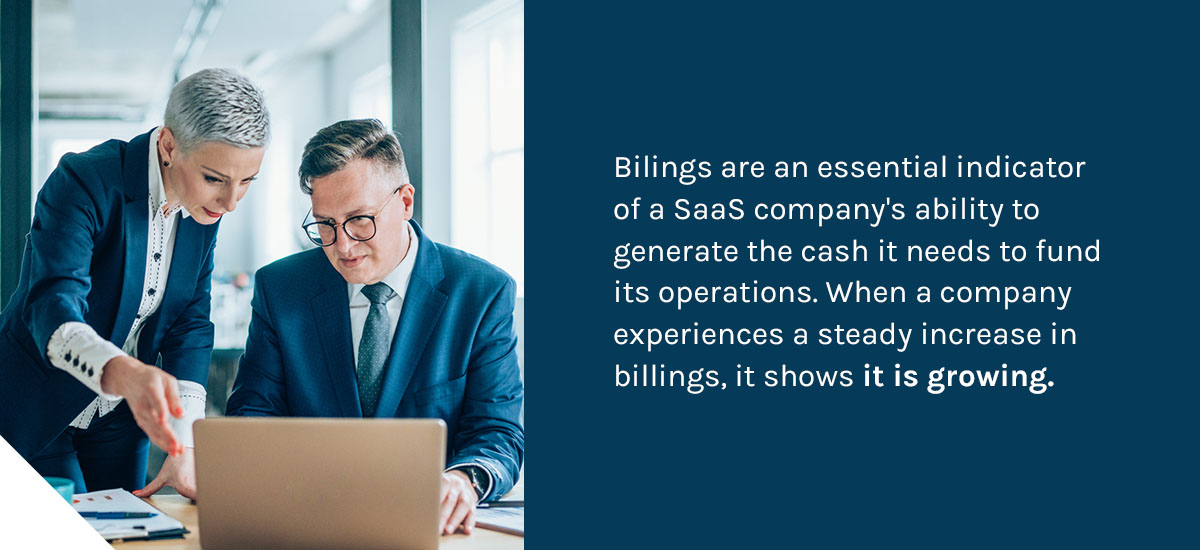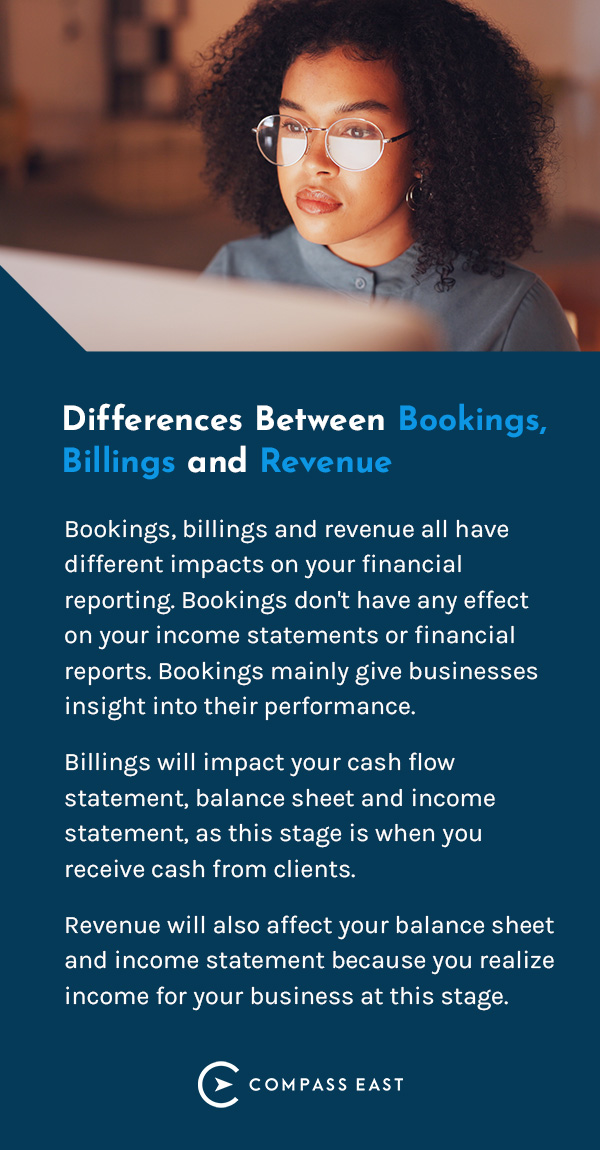Bookings, invoicing and revenue are three elements that allow SaaS companies to track, understand and forecast their business performance. Although there is a link between the three, as they make up the SaaS revenue cycle, they are not interchangeable terms.
Each of these metrics gives businesses insights into different aspects of their financial health. As a business owner, knowing the differences between these metrics and what they tell you about your performance is important. In this article, we’ll break down each metric, their role and how you can calculate them.
Bookings in a SaaS Company
Bookings are a forward-looking metric showing companies the value of the contracts signed. Understanding bookings is essential for business health and the sales process.
What Is a Booking?
A booking refers to when a customer books a product or service. The customer signs a contract committing to spend money on your product or service. Bookings are important because they indicate the demand and market response to your product or service.
Companies must keep a close eye on bookings to understand whether they successfully convert leads into customers. SaaS businesses record bookings as an annual number, but the bookings can be less than a year or extend over one year.
You can collect the payments from bookings at the contract’s beginning or end. When you collect payment at the beginning, it becomes deferred revenue, which is a liability. This is because you have an obligation to carry out the service or deliver the product to the client.
Types of Bookings
There are three main ways that businesses can classify their bookings:
- New bookings: When new customers sign a contract for a product or service, they are new bookings. A new booking also applies when an existing customer signs up for a new service or product offering.
- Upgraded or upsell bookings: If existing customers complete a booking to upgrade their purchase to a more extensive package that includes more services.
- Renewal bookings: When existing customers renew their contract for a product or service they already use. You can calculate the renewal on the effective renewal date or when you receive the request to renew.
Besides these three main categories, some companies also measure a fourth booking:
- Non-recurring bookings: Even if customers have recurring bookings, these are some aspects that will be non-recurring. Items such as setup fees, discounts, training fees and other once-off costs fall under non-recurring bookings.

The Importance of Bookings
Bookings provide a view of the growth trajectory of your business. They are particularly beneficial for companies still in the early stages of development with little revenue. Bookings can indicate the willingness of customers to purchase the product or service.
The more customers are willing to commit to contracts, the more revenue the business can expect in the future. As companies become more established, they can use booking trends to improve assumptions about long-term revenue and create an achievable operating plan.
Sales and marketing teams should also pay close attention to bookings for customer acquisition strategies. They can draw insights by looking at which leads converted, what contracts they signed, which salesperson signed the customer and other aspects to improve customer acquisition, retention and upgrades.
As bookings increase, revenue will usually increase later on. An increase in bookings shows a strong market demand for your products or services. A decrease in bookings points to issues you must address — it can show that your sales team is having trouble attracting new customers or getting existing customers to sign new contracts. When bookings decrease, your revenue will likely decline in the future.
Calculating Bookings
When measuring bookings, companies look at the value of the contracts between clients on the date they formalize the agreement. This value is a critical metric and may even be a more informative measurement of top-line growth than revenue.
Unlike revenue, bookings are a forward-looking metric that does not understate the value of customer contracts. There are two primary formulas that businesses use to calculate bookings:
- Total contract value (TCV) bookings: This value represents the total sum of all the company’s bookings. The amount disregards the contract term. For example, if a customer signs a three-year contract, the total contract value booking value will be based on all three years.
- Annual contract value (ACV) bookings: You can calculate ACV by taking the company’s TCV bookings and dividing it by the contract term. For example, for a three-year contract, you’ll take the value and divide it by three.
If your company uses a monthly billing cycle, you’ll need to use the ACV and divide it by 12 to determine the monthly amount you bill.
Billings in a SaaS Company
After bookings, the next stage is billings. The cash flow of an SaaS business depends on how it handles its billing process. The process of converting bookings to invoices gives insight into the money your company will receive.
What Is Billing?
Billing is when a business collects money from customers’ bookings. Matching and analyzing your booking and billing status will help you better understand your business’s position. If your billing status does not match your booking status, your business may run into cash flow challenges in the future.
It’s important to note that not all bills are guaranteed revenue, as some may become uncollectible. Your billings will only translate into revenue once you render the service or deliver the product to the customers. The billed amount remains a liability until you provide the product or service to the customer.

The Importance of Billings
Bilings are an essential indicator of a SaaS company’s ability to generate the cash it needs to fund its operations. When a company experiences a steady increase in billings, it shows it is growing. Recurring charges show that the customer base is expanding or that existing customers are signing up for new products or service offerings. Essentially, billing reflects on the health of a company — when it starts to decline, it may run into cash flow issues.
Some businesses accelerate their influx of cash flow by billing customers in advance for the total amount of their contract. It is important to note that billings also include charges such as initial fees for training or setup fees.
How to Increase Billings
Understanding your billings is the first step to improving your cash flow. For an SaaS company to be self-sustainable and grow, it needs to generate a steady cash flow. Here are two ways you can increase your billings and cash flow:
- Offer discounts: You can encourage customers to sign up and pay in advance by offering discounted fees, free extras or upgrades. Having the additional cash in advance will be worth the reduction in revenue from the discount — receiving payments in advance is crucial in the early stages of business or if your business is growing rapidly. Having extra cash on hand will create a buffer to avoid a cash flow crunch or overworking your staff if you can’t expand your team.
- Convert contracts: Monthly contracts are convenient for customers but a pain for companies, as customers can cancel anytime. Converting your monthly contracts to annual ones can help to steady your cash flow. You can encourage customers to convert by offering incentives like set prices throughout the contract. If your customers are happy with your product or service, it will be easier to push them to convert.
Revenue in a SaaS Company
Revenue is the final stage after booking and billing. At this stage, a company delivers the good or service to their customer and recognizes the billed amount as revenue.
What Is Revenue?
Revenue is the amount a business earns once it delivers products or services to customers. As per general accepted accounting principles (GAAP), companies can only recognize amounts as revenue once they earn it — regardless of when they invoice customers or receive payment. You only earn your revenue once you deliver the goods or services.
Your revenue is your sales value minus any discounts, returns or other allowances. Unlike billings and bookings, revenue is a GAAP metric. You must follow the guidance in GAAP ASC 606whenreporting your revenue to ensure consistency and comparability with other companies.
Because SaaS products are subscription-based, companies recognize the revenue over the contract’s lifetime. Revenue is a crucial indicator of financial health because it shows the company’s actual position. Relying on billing and booking values alone can give an inflated perspective of your business’s finances.
The Importance of Revenue
Your revenue strongly indicates your ability to build a sustainable business. This metric is important to stakeholders such as managers, lenders, investors, analysts and investors. For example, investors will scrutinize the revenue of your business to determine whether or not to provide you with funding.
Revenue is also a better indicator of a company’s financial position than billing because you only record your revenue as you earn it. For example, if you bill a client a year in advance, you’ll only record the revenue at the end of every month after you render the service.
Using your monthly revenue and other data, you can analyze and predict trends in your business, which helps forecast plans. You’ll also need to invest in activities like marketing, sales and research and development to grow your business. Calculating your revenue will help you set a budget for reinvesting in your business. You’ll have a good understanding of how much you can invest without putting it at risk.
Revenue can also help you to understand your customer churn rate. This metric is the percentage of customers that cancel their subscriptions. You can calculate your revenue churn rate if you know how much your revenue was for the month and how many customers you lost.
Calculating Revenue
SaaS company customers often have subscriptions of varying lengths, so they need a consistent way to track revenue. These metrics can help companies track their monthly or annual revenue regardless of the contract length.
- Monthly recurring revenue (MRR): This metric is one of the main ones that SaaS companies use to track how much revenue they make monthly. It is the total amount of recurring revenue you earn each month from your customers. Monthly recurring revenue can include monthly subscription fees, usage-based fees and even support fees that customers pay monthly. Several factors can affect your MRR, such as new customers, additional revenue from existing customers and revenue lost from customs who leave.
- Annual recurring revenue (ARR): This metric is similar to MRR, except it measures the yearly revenue from subscriptions. ARR is the sum of your yearly subscriptions plus revenue from other add-ons and upgrades, less revenues lost from downgrades and cancellations. You can also calculate your annual revenue by multiplying your monthly revenue by 12.
When you calculate your recurring revenue, it can be easy to miss non-recurring elements. Make sure to exclude items such as set-up fees, credit adjustments, non-recurring add-ons and one-time charges.

Differences Between Bookings, Billings and Revenue
Now that you understand these three metrics and their importance in SaaS companies, let’s look at their differences.
One of the significant differences between all three is the stages at which they occur. Bookings are the initial stage when customers sign a contract for a product or service you deliver. The second stage is billings. At this point, customers make a payment, which you collect for the product or service. The final stage is revenue, which is the amount you earn when delivering your product or service to your customers. You can think of bookings, billings and revenue as three different stages.
Bookings, billings and revenue all have different impacts on your financial reporting. Bookings don’t have any effect on your income statements or financial reports. Bookings mainly give businesses insight into their performance. Billings will impact your cash flow statement, balance sheet and income statement, as this stage is when you receive cash from clients. Revenue will also affect your balance sheet and income statement because you realize income for your business at this stage.
Knowing the differences between these three elements also informs the performance of different functions of your business. For example, if you’re meeting your bookings goals, it shows that your sales team is successfully bringing in new clients. However, if your billings don’t correlate to your bookings, it may point to problems with your billing department. You can identify business gaps and make improvements by comparing the two metrics.
Partner With Compass East for Financial Growth
Bookings, billings and revenue are metrics every SaaS company needs to track to understand their business performance. Even though some use these terms interchangeably, they have very different implications for a business.
When you analyze and use these metrics correctly, you can make better-informed decisions for your business. Leveraging your bookings, billings and revenue for financial growth is essential, but it can be tricky to do when you’re busy running your business.
At Compass East, we have a proven track record of providing companies in various industries with finance and accounting services that free owners to focus on growing their businesses. When you partner with us, you gain an in-depth analysis of your bookings, billings and revenue to make informed decisions for the future. Contact us today to grow your business!

